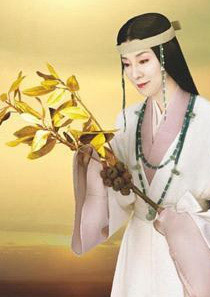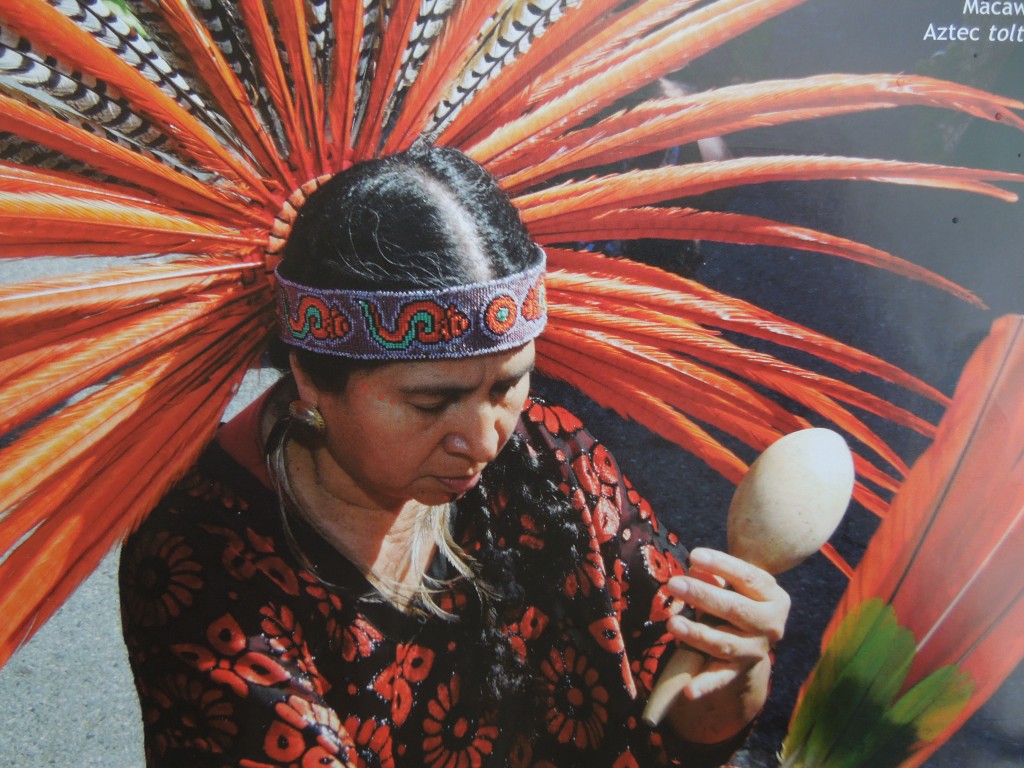For the Toltecs energy is called teotl and is seen as divine. It’s been translated as God, though it’s more akin to ‘kami’ in Japanese… It’s just one of the common points between Shinto and the shamanism of the native Mexican people. “It is worth noting,” writes Victor Sanchez in Toltecas del Nuevo Milenio, “that to both the Totecs of ancient times and to the surviving peoples of today, religion was not a set of predetermined patterns of behavior, dogmas or the projection of self-importance, but a series of practices that were aimed to keep man in touch with Spirit.’ Maintaining harmony is key.

Himiko as played by Sayuri Yoshinaga in 'Maboroshi no Yamataikoku'
The main Toltec practice is shamanic journeying, in which the shaman enters into a trance through the help of the drum and natural substances. In proto-Shinto too there were female shamans who travelled into the spirit world to make contact with transcendental powers. The most famous of the early shamans was Queen Himiko (c.175-248). Another was that of Usa Hachiman, where a female oracle worked with a male medium of communication.
The female shamans were driven out of the mainstream as male ritualists came to dominance following the appropriation of kami worship by a centralising state after the time of Emperor Tenmu (c.631-686). Instead of travelling into the spirit world, the ritualists invited the spirits down, made offerings and conducted ceremonies to placate them. Kami oroshi (descent of the kami) and kami okuri (sending off the kami) still form an important of rituals. Instead of a vehicle for shamanic flight, the drum became a symbolic marker of the beginning and end of ceremonies.
Purification and healing are important aspects of shamanic cultures, and for the Toltecs this is done with a branch to which feathers are attached. It is used in healing ceremonies to cleanse a person’s aura. In Shinto a sakaki branch with white strips of paper attached is used in similar manner as a means of purification.
As with other primal religions, human beings are presumed to have an innate sense of virtue. ‘We only need to look at the inner universe that every human being has within them, and there is a master, a true guide, and the true knowledge that comes from contact with the infinite,’ says the Toltec shaman, Wirikuta Maza Mau. Shinto treasures sincerity and purity for similar reasons. “The important thing is to live in the moment, being one with all that is,’ stresses Wirikuta. In Shinto this equates to the concept of nakaima (literally, the middle of now i.e. the present moment).
Japan and Mexico are not usually thought of a sharing much in common, but here in the ancient practices can be found two ends of the same circle.

Toltec shaman dancer, with macaw feathers
******************************************************************************************
Information and quotations are taken from Sacred Hoop magazine, Issue 73, and Shamanism, An Encyclopedia of World Beliefs, Practices, and Culture by Mariko Namba Walter et al.

Usa Hachiman, where a female oracle worked with a male medium of communication.
Well, *that* sounds familiar… :)
The Fujikyo sect that I have been actively participating in still does this. The shamaness takes the kami into her body during the ceremony. When she feels the connection, she signals this with a rapturous pose. The ceremony stops, and the kami speaks through the priestess. The male priest leading the ceremony (they seem to insist on having a male do this, even if the ladies have to lead him through it) then releases her from the possession by drawing a circle with two fingers (index and middle, right hand) in the air three times and then stabbing through it at the shamaness with a gutteral shout (John, you might know a term for this action). In the absence of a man, I think a lady could also lead the ceremony, and conversely, in the absence of a lady, a man could receive the spirit, but I am told it works best with a man and woman participating in these separate roles, but otherwise equal.
John, I’m having a great time going through your archives! I wanted to add one more interesting observation to the above. The “ohnusa” wand used in purification has the evergreen sakaki branch (or a stick) with paper, but most importantly (so important that it is the name for the object itself) is hemp fibers tied on and somewhat obscured by the paper. “Ohnusa” 大麻 literally means “marijuana” with a different pronunciation. Which of course is illegal now in Japan, so they have to import hemp seeds (for shichimi togarashi) and hemp fibers grown elsewhere.
Many thanks for your input, Pat. It’s very valuable, coming from a practitioner of Shinto…
All this is just amazing and I would like to participate in one of these workshops. My email is attached send any info you like, and thank you for all the work and dedication you put into this.
Thank you for your appreciation. Please continue to watch this space!